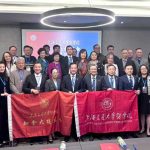Korean pottery
Wikipedia, the free encyclopedia – Cite This Source
Korean pottery appeared later than south Chinese pottery, and required a reasonably stable village culture before domestic Korean potter’s wheels and kilns could be produced. Estimates are that Korean pottery history go back to the early Silla period, from domestic ware of clay that followed, and was within the Korean ceramics tradition.
Early history
See also: Jeulmun Pottery Period, Mumun Pottery Period
Chinese influences
With many scholars, and trade missions sent to China, the Koreans who returned brought back many fine samples of the best of Chinese potters’ wares, and may have indeed as well studied in China, or brought back Chinese clay as ballast to make Korean artifacts. The styles of China, the forms, approaches, the glazes and glazing methods, all were the early foundations of Korean pottery.
Chinese influences continued – particularly in the choice of glaze colour, shapes and forms, and use of brushes and techniques – until well into the mid-20th century. After 1949, Chinese influence declined in partitioned Korea as a result of the fear of communism amongst southern politicians, who also included cultural influences in that fear. In the post-Deng Xiaoping era, however, once again Chinese and Korean potters began exchanges.
Three Kingdoms pottery
The Three Kingdoms of Silla, Goguryeo, and Baekje from 57 BCE to 668 CE, provided the basis for Korean pottery.
Rough domestic work for the people were produced from numerous kilns, as well as a number of very sophisticated statues of royal figures, guardians, and horses, equivalent to Chinese Han Dynasty figures, used for domestic and imperial votive shrines as well as for escorts of the dead in tombs of the nobles and kings, some of whose elements were turned on potter’s wheels, others being built using the traditional hammered clay and coil method.
Silla Era pottery
During the Silla Era (668–935) pottery was simple in colour, shape, and design. Celadon was the main production, with baekja porcelain wares developing slowly until the 14th century, when the pace accelerated with new glazes, better clays, and surprising variations of white on different clays.
The kilns at the time had to compete with Chinese wares on a variety of social levels, and the Korean workmasters decided to distinguish Korean baekja or white porcelain from Chinese imports by maintaining simplicity in design when the practical problems of finding pure white glazes were solved. Dating of glazes from this era has revealed a celadon or jade patina beneath the white glazes.
Baekja wares came from highly refined white clay, glazed with feldspar, and fired in large carefully regulated very clean kilns. Despite the refining process, glazes in white colours always vary as a result of the properties of the clay itself; firing methods were not uniform, temperatures varied, and glazes on pieces vary from pure white, in almost snowy thickness, through milky white that shows the clay beneath deliberately in washed glaze, to light blue and light yellow patinas.
The baekja wares reached their zenith immediately before the Joseon Dynasty came to power. Fine pieces have recently been found in the area about Wolchil Peak in the Diamond Mountains. The transitional wares of white became fields for Joseon Dynasty celebrations of victory in many pieces decorated with Korean calligraphy. Traditionally white wares were used by both the scholarly Confucian class, the nobility, and royalty on the more formal occasions.
Simultaneously, the Buddhist traditions demanded celadon-glazed porcelain, and cheongja wares of celadon porcelain with more organic shapes drawing on gourds, with animal and bird motifs evolved very quickly. In some ways these were over-decorated wares, using exaggerated forms, stylized repeating designs, and a wide variety of organic patterns.
Cheongja wares used a refined earth clays with a bit of iron powder added, then a glaze with a bit of added iron powder added once again, then fired. The glaze dries hard and is hard wearing and slightly shinier and glossier in an oily way than whitewares.
Goryeo Dynasty
The Goryeo Dynasty (918–1392) achieved the unfication of the Latter Three Kingdoms under King Taejo. The works of this period are considered by some to be the finest small-scale works of pottery in existence.
Key-fret, foliate designs, geometric or scrolling flowerhead bands, elliptical panels, stylized fish and insects, and the use of incised designs began at this time. Glazes were usually various shades of celadon, with browned glazes to almost black glazes being used for stoneware and storage. Celadon glazes could be rendered almost transparent to show black and white inlays.
While the forms generally seen are broad-shouldered bottles, larger low bowls or shallow smaller bowls, highly decorated celadon cosmetic boxes, and small slip-inlaid cups, the Buddhist potteries also produced melon-shaped vases, chrysanthemum cups often of spectacularly architectural design on stands with lotus motifs and lotus flower heads. In-curving rimmed alms bowls have also been discovered similar to Korean metalware. Wine cups often had a tall foot which rested on dish-shaped stands.
Joseon Dynasty pottery
During the Joseon Dynasty, (1392–1910) pottery was considered to represent the highest quality of achievement from imperial, city, and provincial kilns, the last of which were export-driven wares. This was the golden age of Korean pottery, with a long period of growth in imperial and provincial kilns, and much work of the highest quality still preserved.
Wares evolved along Chinese lines in terms of colour, shape, and technique. Celadon, white porcelain, and storage pottery were similar, but with slight variations in glazes, incision designs, florality, and weight. The Ming influence in blue and white wares using cobalt-blue glazes existed, but without the pthalo blue range, and the three-dimensional glassine colour depth of Ming Dynasty Chinese works.
Simplified designs emerged early on. Buddhist designs still prevailed in celadon wares: lotus flowers, and willow trees. The form most often seen was that of pear-shaped bottles. Notable were thinner glazes, and colourless glazes for buncheong or stoneware.
After the prolonged fall of the Ming dynasty, immigration of some Chinese master potters occurred in southern coastal Korea. Q’ing colouring, brighter and almost Scythian in enamel imitation, was rejected by Korean potters, in favour of simpler, less decorated wares in keeping with a new dynasty that built itself on military tradition.
Generally, the pottery of this dynasty is divided into early, middle, and late periods, changing every two centuries, approximately; thus 1300 to 1500 is the early period, 1500 to 1700 the middle, and 1700 to 1900–1910 the late period). he wares began to assume more traditional Korean glazes and more specific designs to meet regional needs. This is to be expected, as the Scythian art influences were of the former dynasty. The rise of white porcelain occurred as a result of Confucian influence and ideals, resulting in purer, less pretentious forms lacking artifice and complexity.
Export-quality pottery
Nearly all exports of Korean pottery went to Japan, and most were from provincial coastal kilns, especially in the Busan area. Export occurred in two ways: either through trading and the voluntary immigration of potters, or through outright invasion and theft of pottery and the kidnapping to Japan of families of potters who made the wares when the first method failed.
The practice of sending paper models of ceramics to Japan, having them approved, and then having them made by the shipload began in the late 17th century, most often for the Japanese Tea Ceremony.
Export-quality pottery was always individual, and lacked the rigid perfectionism and uniformity of Chinese exports.
Occupied Korea and Japanese restraints
After 1945
Contemporary pottery
Much work explores new forms with traditional glazes. Some work can best be described as sculptural.
Kilns
Central to Korean success were the chambered climbing kilns that were used throughout the Joseon dynasty and exported abroad, especially to Japan by Korean kiln-makers where they were renamed as noborigama in the Karatsu area from the 17th century on.
Today most kilns used are electric kilns with computer controlled switchoffs, replacing first generation electric kilns with ceramic cones used as timers. There are, however, also artists using gas-fired kilns.
Centers for studying Korean pottery
Department of Ceramics at the College of Art and Design, Ewha Woman’s University in Seoul
See also
List of Korea-related topics
Korean art
List of Korean ceramic artists and sculptors
Korean Pottery: Categorized by Periods
External links
Over 120 pictures of Korean Pottery from the [[Freer Gallery] ]
Koryo dynasty
Korean ceramics Details of an exhibition at the Smithsonian Institution
Cultural Assets of Korea
Comprehensive Archaeological Bibliography of Korean Pottery
Talks on the Korean impact on Japanese ceramics
Joseon Dragon vase with softer watery-blue glaze and naturalistic brush-strokes
From the Fire: Contemporary Korean ceramics International Arts Cermaic Artists exhibition
Mountain Dreams: Contemporary Ceramics by Yoon Kwang-cho — Philadelphia Museum of Art exhibition



